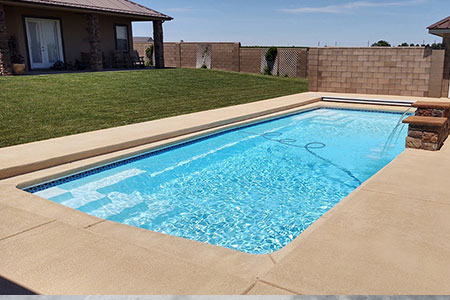Fiberglass Vs Plaster

Fiberglass surface is superior to plaster for a variety of reasons.
Fiberglass Pools Save Money and Time
- No Rough Surfaces
As plaster wears, roughness increases. Fiberglass is always smooth. No scratched feet and toes. - No Structural Cracks
Any substantial pool movement can cause cracks and leaks. Fiberglass adds structural strength to pool shell. Prevents leaking. - No Blemishes and Stains
Plaster has little resistance to stains and blemishes even if surface has been recently applied. Resistance to stains with easily cleaned surface. - Algae Resistant
Algae adheres to porous surface. Smooth, dense, non-porous surface prevents algae from adhering. - Lower Chemical Demand
High chemical requirement at all times. Reactive surface Noticeable reduction chemical usage due to the inert nature of fiberglass. Makes pool chemicals more efficient. - Attractiveness
Unsightly when stained/deteriorated, whereas fiberglass maintains attractive appearance. - Durability
Depends on application. Re-plastering often separates from original surface (poor adhesion). Material limitations reduce the durability of plaster. The superior corrosion resistant and inert properties of fiberglass ensure exceptional durability. - Water Chemistry
Very sensitive to incorrect water chemistry. Plaster surface easily compromised. Inert surface of fiberblass is less sensitive to out-of-balance water chemistry. - Life Expectancy Varies
Depends on water chemistry, maintenance regime, plaster mix, and application technique. Fiberglass exceeds that of plaster. Time tested with 25 years industry experience. - Leachable Material
Salts/plaster constituents will adhere, and create a very abrasive surface. Due to the inert nature of fiberglass, no leachable material is available to cause roughness. Surface remains smooth. - Complicated Start-up
Plaster requires brushing and attention. With Fiberglass, no brushing is needed. Allow to cure, then start-up.